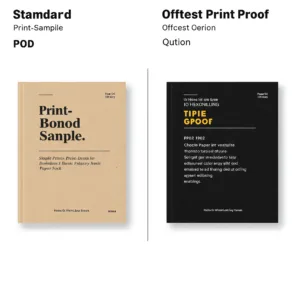Ready to tap into the power of China’s printing industry but feeling a bit lost in translation? Don’t worry, we’ve got you covered! This comprehensive guide will walk you through the ins and outs of communicating with Chinese printing suppliers, from overcoming language barriers to navigating cultural nuances.
Communicating effectively with Chinese printing suppliers involves a combination of clear communication, cultural sensitivity, and proactive relationship-building. Use concise language, visual aids, and translation tools to bridge language gaps. Be mindful of Chinese business etiquette, build rapport, and be patient in negotiations. Clearly communicate quality standards, utilize secure payment methods, and protect your intellectual property.
Think that’s all there is to it? Think again! We’ll dive deeper into finding the right suppliers, mastering communication techniques, ensuring quality control, and building long-term partnerships that will benefit your business for years to come.
Understanding the Landscape
Why Source Printing from China?

- Cost-effectiveness: Let’s face it, printing costs can eat into your budget. Chinese printing suppliers often offer significantly lower prices than domestic options, thanks to lower labor costs and economies of scale. This can be especially beneficial if you’re printing in bulk, like for large book orders or extensive marketing materials.
Need a refresher on bulk printing benefits? Check out our article: What are the Benefits of Print Books in Bulk? - Wide range of suppliers and capabilities: Whatever your printing needs, you’re likely to find a supplier in China that can meet them. From basic brochures to complex packaging, China boasts a diverse printing industry with expertise in various techniques and materials.
- Access to specialized printing techniques: China is at the forefront of printing innovation, consistently investing in cutting-edge technologies and sustainable practices. For a deeper dive into these advancements, check out this in-depth analysis of the Chinese printing industry’s trends.
You can find suppliers specializing in unique techniques like lenticular printing, holographic foiling, and intricate embossing, adding a distinctive touch to your printed materials.
Challenges of Communicating with Chinese Suppliers

Of course, sourcing from overseas comes with its own set of challenges, and communication is often at the top of the list. Here are some common hurdles you might encounter:
- Language barriers: While many Chinese suppliers have some English proficiency, it may not be their first language. This can lead to misunderstandings and misinterpretations, especially when discussing technical details or complex designs.
- Cultural differences: China has a unique business culture that differs significantly from Western norms. Understanding these cultural nuances is essential for building rapport and avoiding potential conflicts.
- Time zone differences: Depending on your location, you might be dealing with a significant time difference, which can make scheduling meetings and getting timely responses a bit tricky.
- Potential quality concerns: Ensuring consistent quality can be a concern when working with any supplier, but the geographical distance and potential communication barriers can add another layer of complexity when sourcing from China.
Don’t let these challenges discourage you! With the right approach and a bit of preparation, you can overcome these obstacles and establish effective communication channels with your Chinese printing partners.
Preparing for Communication
Finding the Right Supplier

Before you even start communicating, you need to find the right supplier for your needs. Here are some avenues to explore:
- Searching on Google: Don’t underestimate the power of a Google search! Use specific keywords to find potential suppliers. For example, if you’re looking for a book printer in China, you might search for “book printing China,” “China book printing companies,” or “printing services China.” You can further refine your search by adding specific requirements like “eco-friendly book printing China” or “hardcover book printing China.”
Or, you can save yourself the hassle and contact Mainland Printing directly! We specialize in providing high-quality, cost-effective book printing and binding solutions, including hardcover, softcover, and various binding styles. Whether you need a small run of custom journals or a large order of textbooks, we have the expertise and resources to meet your needs. - Utilizing online platforms: Online B2B marketplaces like Alibaba and Global Sources are treasure troves of potential suppliers. You can browse through their profiles, compare prices, and even contact them directly through the platform.
- Attending trade shows: Trade shows offer a fantastic opportunity to meet suppliers face-to-face, see their samples, and get a feel for their capabilities. For instance, the Printing South China trade show in Guangzhou brings together hundreds of printing companies from across China.
- Leveraging sourcing agents: If you’re feeling overwhelmed by the sourcing process, consider working with a sourcing agent. They can provide valuable expertise and guidance, especially when navigating the complexities of international trade.
To learn more about the benefits and considerations of using a sourcing agent, read this helpful guide on How to Find a Reliable Sourcing Agent in China? from the Owlsourcing. They have established networks and can help you find reliable suppliers that meet your specific requirements.
Gathering Essential Information
Table Title: Key Considerations for Effective Communication with Chinese Printing Suppliers
| Aspect | Challenges | Solutions | Best Practices |
| Language |
• Different native languages (Mandarin, Cantonese)
• Varying levels of English proficiency |
• Utilize translation tools (Google Translate, DeepL) • Hire interpreters for crucial conversations • Learn basic Mandarin phrases • Use clear and concise language • Provide detailed specifications and requirements |
• Use visual aids (diagrams, images)
• Confirm key details in writing • Speak slowly and clearly during verbal communication |
| Culture | • Indirect communication style • Emphasis on saving face • Importance of building relationships • Different business etiquette (greetings, gift-giving) |
• Be mindful of cultural sensitivities • Adapt communication style • Build rapport and trust • Be patient and flexible |
• Research Chinese business culture and etiquette
• Show respect for hierarchy and seniority |
| Quality | • Potential for miscommunication about quality standards • Difficulty in monitoring production remotely |
• Provide clear quality standards and tolerances • Request samples and prototypes • Implement quality control checks (inspections, third-party verification) |
• Use a detailed product specification sheet
• Document quality control procedures and agreements |
| Logistics | • Time zone differences • International shipping complexities (customs, regulations) |
• Schedule communication during mutually convenient times • Use reliable shipping and logistics providers • Understand import/export regulations |
• Clearly define delivery timelines and expectations
• Use tracking systems to monitor shipments |
| Legal & Financial | • Intellectual property protection concerns • Payment security risks |
• Use non-disclosure agreements • Secure payment methods (letters of credit, escrow) • Understand contract terms and conditions • Seek legal advice when necessary |
• Document all agreements in writing
• Consult with legal experts for complex transactions |
| Technology | • Varying levels of technology adoption • Preference for certain communication platforms (WeChat) |
• Adapt to the supplier’s preferred communication methods • Provide clear instructions and support for technology use |
• Use a variety of communication channels (email, video conferencing, messaging apps)
• Ensure compatibility of file formats and software |
Once you’ve identified potential suppliers, it’s time to gather all the essential information you’ll need for clear communication:
- Defining product specifications: Be meticulous in outlining your product specifications. This includes everything from paper type and weight to dimensions, finishing options (like lamination or UV coating), and binding methods.
Need help with binding types? We’ve got you covered: 10 Types of Book Binding You Should Know About (With Examples) - Determining quantities and budget: Clearly define your order quantity and budget constraints. This will help suppliers provide accurate quotes and avoid unnecessary back-and-forth.
- Understanding import/export regulations: Familiarize yourself with the import/export regulations for your product and country. This will ensure a smooth shipping process and prevent unexpected delays or costs.
With this information in hand, you’re ready to start communicating with your potential suppliers!
Mastering Communication Techniques
Bridging the Language Gap
Even with some English proficiency on the supplier’s side, language barriers can still arise. Here’s how to overcome them:
- Utilizing translation tools: Don’t be afraid to leverage translation tools like Google Translate or DeepL. While they might not be perfect, they can be incredibly helpful for understanding basic communication and even translating technical terms.
- Hiring interpreters for crucial conversations: For critical negotiations or complex technical discussions, consider hiring a professional interpreter. This can ensure accurate communication and prevent costly misunderstandings.
- Learning basic Mandarin phrases: Even a few basic Mandarin phrases can go a long way in building rapport and demonstrating your willingness to engage with their culture. A simple “Ni hao” (hello) or “Xie xie” (thank you) can make a positive impression.
Tutorial: Using WeChat for communication with suppliers

WeChat is the most popular messaging app in China, and many suppliers prefer it for quick communication. Here’s a quick tutorial on how to use it:
- Download and install the app: WeChat is available for both iOS and Android devices.
- Create an account: You’ll need a phone number to register.
- Add your supplier’s contact: You can add contacts by scanning their QR code or searching for their WeChat ID.
- Start chatting: WeChat offers text messaging, voice calls, video calls, and even file sharing. It’s a versatile tool for staying connected with your suppliers.
Want to become a WeChat pro? Check out this comprehensive guide on how to use WeChat like a local!
Written Communication Best Practices
Email remains a primary communication channel in business, especially for sharing detailed information and documents. Here’s how to make your emails clear and effective:
- Crafting clear and concise emails: Get straight to the point and avoid unnecessary fluff. Use short sentences and paragraphs, and break down complex information into bullet points or numbered lists.
- Using visual aids: A picture is worth a thousand words, right? Include diagrams, images, or even videos to illustrate your design concepts or product specifications.
- Providing detailed specifications and requirements: Don’t leave any room for ambiguity. Clearly outline your expectations for materials, dimensions, colors, finishing, and packaging.
Example: Sample email template for requesting a quote
Subject: Quote Request for [Your Company Name] – [Product Name]
Dear [Supplier Name],
My name is [Your Name] from [Your Company Name]. We are interested in sourcing [product name] from your company.
Please find attached the detailed specifications for our product, including:
- [List of specifications]
We require a quantity of [quantity] units. Please provide a quote that includes:
- [List of items to include in the quote]
We look forward to your response.
Sincerely,
[Your Name]
Effective Verbal Communication
Whether you’re having a phone call or a video conference, keep these tips in mind:
- Scheduling calls during mutually convenient times: Be mindful of the time difference and schedule calls when both parties are available and alert.
- Speaking slowly and clearly: Enunciate your words and avoid using slang or idioms that might be difficult to understand.
- Confirming key details in writing: After a verbal conversation, follow up with an email summarizing the key points discussed. This helps ensure everyone is on the same page and prevents misunderstandings.
Navigating Cultural Nuances
Building strong relationships with Chinese suppliers requires cultural sensitivity and understanding. Here are some key considerations:
- Understanding Chinese business etiquette: Familiarize yourself with basic Chinese business etiquette, such as greetings, gift-giving, and dining customs. For example, addressing your contact with their title and last name (e.g., Mr. Wang) is a sign of respect.
- Building rapport and trust: Chinese business culture places a high value on relationships. Take the time to build rapport and establish trust before diving into business negotiations.
- Being patient and adaptable: Things might move at a different pace in China. Be patient and flexible, and be prepared to adapt your communication style to suit the situation.
Gary Huang, a cross-cultural communication consultant, emphasizes the importance of understanding Chinese communication styles: “Chinese communication tends to be more indirect and high-context. Pay attention to nonverbal cues and be mindful of saving face. Building trust and rapport is crucial for successful interactions.”
Ensuring Quality and Managing Risks
Communicating Quality Expectations
Quality is paramount, and clear communication is key to ensuring your printed materials meet your standards.
- Providing clear quality standards and tolerances: Don’t assume your supplier knows your expectations. Provide detailed specifications, including acceptable tolerances for color variations, registration, and other critical aspects.
- Requesting samples and prototypes: Before committing to a large order, request samples or prototypes to evaluate the supplier’s capabilities and ensure they can meet your quality requirements.
- Implementing quality control checks: Discuss quality control procedures with your supplier and consider incorporating inspections at various stages of the production process. You can even hire a third-party inspection company to conduct independent quality checks.
Case Study: A US-based apparel company ordered a large batch of printed t-shirts from a Chinese supplier. They failed to clearly communicate their color specifications, resulting in a shipment of shirts with a slightly different shade than intended. This miscommunication led to delays, additional costs, and strained relationships. Lesson learned: Clear communication about quality expectations is crucial from the outset.
Mitigating Potential Risks
While sourcing from China offers many advantages, it’s essential to be aware of potential risks and take steps to mitigate them.
- Protecting intellectual property: If you’re printing proprietary designs or artwork, take steps to protect your intellectual property. This might involve non-disclosure agreements, trademarks, or design patents.
- Secure payment methods: Use secure payment methods like letters of credit or escrow services to protect your financial interests. Avoid making large upfront payments without proper safeguards in place.
- Understanding contract terms and conditions: Carefully review the contract terms and conditions, paying close attention to clauses related to quality, delivery, and dispute resolution.
Maggie M. Chen, an expert in international business law, advises: “When working with Chinese suppliers, it’s crucial to have a clear contractual agreement in place that outlines the rights and obligations of both parties. Seek legal advice to ensure your interests are protected, especially when it comes to intellectual property.”
Building Long-Term Relationships
While a single printing project might be your immediate goal, building long-term relationships with your Chinese suppliers can bring significant benefits.
Cultivating Trust and Collaboration
Open and honest communication is the foundation of any strong relationship. Regularly communicate with your suppliers, provide feedback, and be proactive in addressing any concerns.
- Visiting suppliers in person: If possible, visit your suppliers in person. This demonstrates your commitment to the relationship and allows you to gain a deeper understanding of their operations and capabilities.
- Understanding long-term goals and values: Take the time to understand your supplier’s long-term goals and values. This can help you align your expectations and build a mutually beneficial partnership.
Example: A US-based publisher established a long-term partnership with a Chinese printing company for their series of educational books. Through regular communication, mutual respect, and a shared commitment to quality, they have built a strong and reliable supply chain, ensuring consistent quality and timely delivery for their publications.
Conclusion
Effectively communicating with Chinese printing suppliers is a multifaceted skill that involves language proficiency, cultural sensitivity, and a proactive approach to problem-solving. By implementing the strategies outlined in this guide, you can overcome communication barriers, build strong relationships, and ensure the success of your printing projects.
Remember, clear communication is the cornerstone of any successful business partnership. So, take the time to invest in your communication skills, and you’ll reap the rewards of a fruitful and long-lasting relationship with your Chinese printing suppliers.
Additional Resources
- Articles:
- Organizations:
- Printing Industries of America: www.printing.org
- China Printing Industries Association: www.cnprint.org.cn







